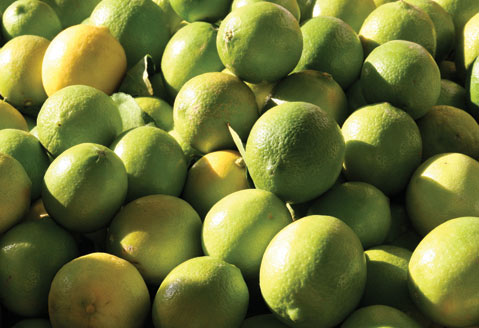Growing Citrus
Lemons, Limes, and Oranges All Flourish in Santa Barbara

Simply Orange is the trade name for a bottled orange juice product (hopefully the label reveals that it is just orange juice); and those little rotund orbs in bright-lemon-yellow and deep-lime-green found in the produce section of most grocery stores profess to contain the pure juice of the fruits they resemble. For many cooks and diners across the country, this kind of processed product has to suffice. In Southern California, there are so many more choices. Here, citrus can be grown in a wide diversity of other flavors and picked fresh year-round.
All citrus have their origins in tropical Asia, but, in Southern California, most will grow well even in interior valleys that experience frost. Microclimate can go a long way to improving flavor in either direction. Lemons and limes will produce fruit of a consistent quality even in the fog zones, but on the coastal strand, plant orange trees in protected south or west-facing sites. Situating them to benefit from reflected heat off walls may really help. Grapefruits need even more heat to be sweet, so site them appropriately, too.
There are plenty varieties of lemons and limes, but most people will be satisfied with the most common ones. Starting with lemons, ‘Meyer’ (and ‘Improved Meyer’, which is less likely to develop a contagious citrus disease) produces large, juicy fruits nearly year-round. ‘Meyer’ lemons are not as acidic as regular lemons but are beloved by many for their great aroma and flavor. ‘Eureka’ is the market favorite. It, too, bears year-round on sturdy, adaptable plants. The lime that flavors your G&T or Margarita is the ‘Mexican’ lime. Small, dark green fruits give that essential burst of flavor to your favorite beverage. Another common one is the ‘Bears’ lime. By the time it is fully ripe, it has mellowed out in both flavor and color (to a pale yellow). Very juicy and very prolific, it is seedless unlike the ‘Mexican’ variety.
There are two large divisions in the sweet orange world: the ‘Navel’ and ‘Valencia’ types. The former is best for fresh eating, and the main crop will be in the winter, while the latter makes great juice and produces fruit in the summer. Then there are the blood oranges (like ‘Moro’ and ‘Sanguinelli’), which really need hot summers to develop their distinctive deep red flesh and sweetest juiciness.
Tangerines — more correctly known as mandarin oranges — are the sweetest citrus of all. That citrus tang is almost wholly absent in this group. The standard is ‘Dancy’, but there are dozens of other varieties. Look for seedlessness (can that be a word?) and ability to set fruit without another variety to pollinate it: ‘Clementine’ and ‘Satsuma’ are others to look for.
Kumquats, limequats, and other oddities abound. Some are edible (hybrids like ‘Tangelo’, a cross between a mandarin and pommelo); some just interesting, like ‘Buddha’s Hand’ citron with finger-like projections. Adaptable garden subjects, handsome foliage, and healthful fruits make citrus trees a great addition to any landscape.
Happily, citrus varieties are now available that don’t require turning the entire garden over to fruit production. Many varieties are now available on several different rootstocks that suit them to garden size trees or even patio containers. It’s possible to grow standard trees that average 20 to 30 feet tall and as wide or dwarf trees that are half that size (or even less).



